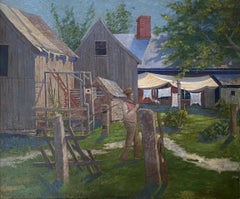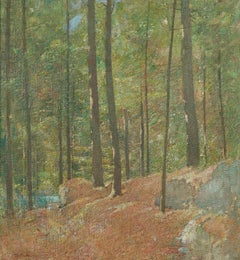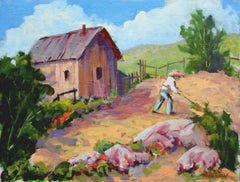Emil Carlsen Paintings
American, 1853-1932
Regarded today as one of the more prominent artists of the late 19th Century, Emil Carlsen spent many years as a penniless painter on the fringes of the art world, while he continued developing his still-life painting techniques that would take the rest of the art world several decades to fully appreciate.
Born Soren Emil Carlsen in Copenhagen around 1853, Carlsen first began his studies at the Royal Danish Academy as a teenager. Yet he was not to remain long there, leaving in 1872, at nineteen years old for America where he settled in Chicago, working for an illustration house to support himself.
By 1875, he had saved enough money to travel to both Paris and Copenhagen to paint and study, staying for six months before returning to America, this time to New York. By this time he had already developed a unique love affair with the still life. In New York he befriended fellow painters such as John Francis Murphy; yet the city could not contain him, and after only a year he relocated to Boston, where he developed a life-long friendship with Childe Hassam.
Carlsen remained quite poor throughout his time in Boston where he spent the next eight years. Yet his abilities were developing quite rapidly in still life painting, in a style which scholars refer to as "kitchen still lifes." These were still life scenes that often included fish or birds along with pots and pans which gave implied presence of the cook outside the frame, giving them a more human element than most still life subjects. This style very much echoed the work of the Dutch and Spanish Masters of still life, particularly that of Jean Simeon Chardin and, to a lesser degree, Johannes Vermeer. The similarity is not coincidental, as Carlsen spoke and wrote often of the influence of these artists on his own work, and yet he was already beginning to develop the eye for color, light and composition that today we regard as the undeniable Carlsen style.
It was not until the 1910's and 20's that Carlsen began to really benefit financially from his painting, even though he'd already had the respect of his fellow artists all along. Despite his long career and his wide travels, he left few written accounts of his travels, and thus there are many in his biography that historians have tried to reconstruct. He often abandoned certain traits only to pick them up again before finally discarding them as he honed his style and his eye. The result is evidence of an artistic meditation that progressed with consistency and caution.
Carlsen's death in 1932 was at the height of his popularity, and he left behind an admirable body of work in which he had redefined the cerebral and metaphysical effects a still life can have on a viewer. (Biography provided by Helicline Fine Art)
to
1
2
2
1
1
1
1
Overall Height
to
Overall Width
to
2
1
1
1
1
1
1
1
1
1
1
1
1
1
2
907
668
660
610
2
2
1
1
Artist: Emil Carlsen
"A Man in His Garden, " Emil Carlsen, Backyard and Barn Impressionist Landscape
By Emil Carlsen
Located in New York, NY
Soren Emil Carlsen (1848 - 1932)
A Man in His Garden, 1893
Oil on canvas
28 3/4 x 35 1/2 inches
Signed and dated lower right
Provenance:
The artist [1848-1932]
Macbeth Gallery, New ...
Category
1890s American Impressionist Emil Carlsen Paintings
Materials
Canvas, Oil
Pine Woods
By Emil Carlsen
Located in New York, NY
Signed lower left: Emil.Carlsen.
Category
20th Century American Impressionist Emil Carlsen Paintings
Materials
Oil
Related Items
Carmel Valley Gardener Landscape
By Ray Barton
Located in Soquel, CA
Painting of a Carmel Valley Gardener by Ray Barton (American, 1918-1988). Ray Barton specialized in plein air paintings of Carmel Valley and Pacific Grov...
Category
1980s American Impressionist Emil Carlsen Paintings
Materials
Canvas, Oil
Morning Sunrise, Mid Century Laguna Hills Figurative Landscape
Located in Soquel, CA
Beautiful mid century plein air figural landscape of Laguna Niguel, California by an unknown artist (American, 20th Century). The morning sun gli...
Category
1950s American Impressionist Emil Carlsen Paintings
Materials
Cardboard, Oil, Canvas
Mid Century Boat Docks Pacific Grove Landscape
Located in Soquel, CA
Painterly scene of boats and boats being built at the docks in old Pacific Grove, California by an unknown artist (American, 20th Century). Signed"WHM" lower left. Presented in a fau...
Category
1950s American Impressionist Emil Carlsen Paintings
Materials
Canvas, Oil, Cardboard
Sail Boats and Calm Water Under West Coast Bridge
By Merlyn Smith Aronovici Moreno
Located in Soquel, CA
Gentle scene of sail boats sailing past a small inviting lighthouse through calm waters on the California Coast. Majority of this peice is light in color, which causes the areas of c...
Category
1980s American Impressionist Emil Carlsen Paintings
Materials
Canvas, Oil
H 37 in W 32 in D 2.125 in
Man and His Guitar Figurative
By Michael William Eggleston
Located in Soquel, CA
Contemporary oil painting of a man playing his guitar on the front porch by San Francisco artist Michael William Eggleston (American, 20th century). From a collection of his works. M...
Category
Early 2000s American Impressionist Emil Carlsen Paintings
Materials
Canvas, Oil
!9th century Impressionist landscape with a horse and cart in a Village
By William Mark Fisher
Located in Woodbury, CT
Outstanding late 19th century English Impressionist landscape, with a horse and cart in a village.
Described in 1893 by George Moore as "our greatest living landscape painter," Will...
Category
1890s American Impressionist Emil Carlsen Paintings
Materials
Canvas, Oil
Free Shipping
H 27 in W 37 in
"The Weaver" - Large Scale Navajo Figurative Landscape
Located in Soquel, CA
Stunning large scale and vivid painting of Native American weaver by Northern California artist Helene Minelli (American, 1918-2010), circa 1980s. Signe...
Category
1980s American Impressionist Emil Carlsen Paintings
Materials
Canvas, Oil
Vintage Figurative Landscape Road Through the Village
Located in Soquel, CA
A small figure with a cart travels through a village down a tree lined road in this vintage figurative landscape done in the style of Utrillo, by Gu...
Category
1980s American Impressionist Emil Carlsen Paintings
Materials
Canvas, Oil
Two Girls on the Beach - Figurative Landscape
By Gladys Hart
Located in Soquel, CA
"Two Girls on the Beach" figurative landscape by Santa Cruz, California artist Gladys Hart (American, 1933-2017). Signed "Hart" lower right. Titled, ...
Category
1990s American Impressionist Emil Carlsen Paintings
Materials
Canvas, Oil
While The Tide is Out, Provincetown
By Alexis Jean Fournier
Located in Milford, NH
A fine impressionist painting on the shore of Cape Cod with cottages, boats, and figures by American artist Alexis Jean Fournier (1865-1948). Fournier was born on the fourth of July ...
Category
Early 20th Century American Impressionist Emil Carlsen Paintings
Materials
Oil, Canvas
Mid Century Figurative Landscape with Red Barn & Yellow Tree
Located in Soquel, CA
Charming mid century figurative landscape of a man walking along a pathway to a red barn with multi-colored trees along side by M. House. Signed "M. House" lower left. Presented in a...
Category
1960s American Impressionist Emil Carlsen Paintings
Materials
Canvas, Oil, Cardboard
"Up the Valley"
By Daniel Garber
Located in Lambertville, NJ
In an original Harer frame.
Illustrated in "Daniel Garber Catalogue Raisonne" Vol. II, pg. 271, and in book titled "Blue Chips", pg. 33
Jim’s of Lambertville is proud to offer this artwork by:
Daniel Garber (1880-1958)
One of the two most important and, so far, the most valuable of the New Hope School Painters, Daniel Garber was born on April 11, 1880, in North Manchester, Indiana. At the age of seventeen, he studied at the Art Academy of Cincinnati with Vincent Nowottny. Moving to Philadelphia in 1899, he first attended classes at the "Darby School," near Fort Washington; a summer school run by Academy instructors Anshutz and Breckenridge. Later that year, he enrolled at the Pennsylvania Academy of the Fine Arts. His instructors at the Academy included Thomas Anshutz, William Merritt Chase and Cecilia Beaux. There Garber met fellow artist Mary Franklin while she was posing as a model for the portrait class of Hugh Breckenridge. After a two year courtship, Garber married Mary Franklin on June 21, 1901.
In May 1905, Garber was awarded the William Emlen Cresson Scholarship from the Pennsylvania Academy, which enabled him to spend two years for independent studies in England, Italy and France. He painted frequently while in Europe, creating a powerful body of colorful impressionist landscapes depicting various rural villages and farms scenes; exhibiting several of these works in the Paris Salon.
Upon his return, Garber began to teach Life and Antique Drawing classes at the Philadelphia School of Design for Women in 1907. In the summer of that same year, Garber and family settled in Lumbertville, Pennsylvania, a small town just north of New Hope. Their new home would come to be known as the "Cuttalossa," named after the creek which occupied part of the land. The family would divide the year, living six months in Philadelphia at the Green Street townhouse while he taught, and the rest of the time in Lambertville. Soon Garber’s career would take off as he began to receive a multitude of prestigious awards for his masterful Pennsylvania landscapes. During the fall of 1909, he was offered a position to teach at the Pennsylvania Academy as an assistant to Thomas Anshutz. Garber became an important instructor at the Academy, where he taught for forty-one years.
Daniel Garber painted masterful landscapes depicting the Pennsylvania and New Jersey countryside surrounding New Hope. Unlike his contemporary, Edward Redfield, Garber painted with a delicate technique using a thin application of paint. His paintings are filled with color and light projecting a feeling of endless depth. Although Like Redfield, Garber painted large exhibition size canvases with the intent of winning medals, and was extremely successful doing so, he was also very adept at painting small gem like paintings. He was also a fine draftsman creating a relatively large body of works on paper, mostly in charcoal, and a rare few works in pastel. Another of Garber’s many talents was etching. He created a series of approximately fifty different scenes, most of which are run in editions of fifty or less etchings per plate.
Throughout his distinguished career, Daniel Garber was awarded some of the highest honors bestowed upon an American artist. Some of his accolades include the First Hallgarten Prize from the National Academy in 1909, the Bronze Medal at the International Exposition in Buenos Aires in 1910, the Walter Lippincott Prize from the Pennsylvania Academy and the Potter Gold Medal at the Art Institute of Chicago in 1911, the Second Clark Prize and the Silver Medal from the Corcoran Gallery of Art for “Wilderness” in 1912, the Gold Medal from the Panama-Pacific Exposition in San Francisco of 1915, the Second Altman Prize in1915, the Shaw prize in 1916, the First Altman Prize in 1917, the Edward Stotesbury Prize in1918, the Temple Gold Medal, in 1919, the First William A...
Category
1940s American Impressionist Emil Carlsen Paintings
Materials
Oil, Panel
Emil Carlsen paintings for sale on 1stDibs.
Find a wide variety of authentic Emil Carlsen paintings available for sale on 1stDibs. You can also browse by medium to find art by Emil Carlsen in oil paint, paint, canvas and more. Much of the original work by this artist or collective was created during the 20th century and is mostly associated with the Impressionist style. Not every interior allows for large Emil Carlsen paintings, so small editions measuring 27 inches across are available. Customers who are interested in this artist might also find the work of Wilson Henry Irvine, Harry Leith-Ross, and Johann Berthelsen. Emil Carlsen paintings prices can differ depending upon medium, time period and other attributes. On 1stDibs, the price for these items starts at $28,500 and tops out at $48,000, while the average work can sell for $38,250.



